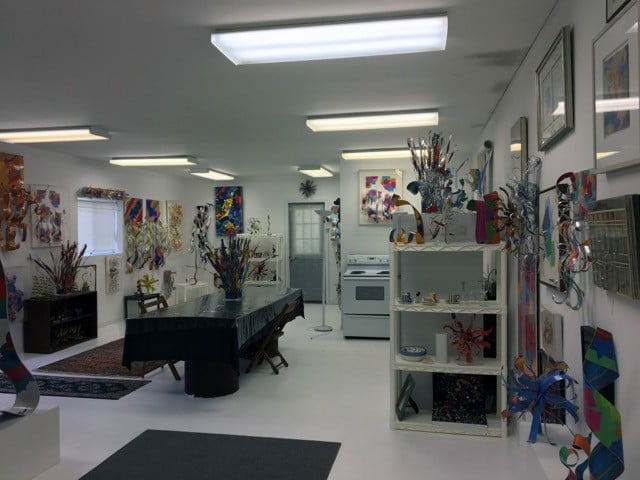
Dorothy Gillespie’s former studio and residence in Narrowsburg, New York – located in the Catskills about 120 miles from New York City.
Radford University students will get a hands-on experience in a studio of the late Dorothy Gillespie – famous for her artistic career – which included the making of nearly 200 sculptures to fill New York’s Rockefeller Center plaza.
Students will experience Gillespie’s studio and residence in Narrowsburg, New York – located in the Catskills about 120 miles from New York City. She built her summer retreat studio 25 years ago on four acres of land, which houses portions of Gillespie’s work from her extensive and distinguished career.
The Roanoke native always felt a connection to Radford University – that connection, stronger than ever – led her son, Gary Israel, to search for a way to help lay the foundation for future artists. Gillespie passed away six years ago, leaving Israel – and his brother and sister – the Dorothy Gillespie Foundation, and upon her passing, the foundation received all of her artwork and other materials.
“If you look at the totality of her life, you can almost see that in the studio,” Israel said of the Catskills retreat. “The studio houses artifacts of her expansive collection – which needs archiving and documentation. That’s where the internship comes into play.”
Israel undertook the daunting task of cataloguing decades of his mother’s work that wound up in that studio. Now, the students will have the opportunity to sift through the work and see the studio first-hand, but the internship is far more than just looking at the works of the influential artist.
“It’s more hands on,” Israel said. “It’s what they can visually see and it’s really open ended with what they can learn. You can touch the portraits she made in the 40s and see the history of her life. It’s an opportunity for Radford students to learn theoretically about artists, especially female artists, and this is an opportunity for them to really learn about Dorothy.”
While Israel has quite the career in his own right – he said that he just doesn’t have the artistic expertise to properly archive all of his mother’s work in the rural studio.
“It’s also what my mother would have wanted,” he said. “She’d want them to do their work and be inspired by her story. While doing this is definitely helpful for me, I just don’t have the time or the expertise.”
As he’s sorted through the collection, Israel has seen some of the drawings fall apart – and recognized the need for proper care and archiving of the pieces. Once that work is underway by the students, Israel has further plans for the Catskills studio.
“I’d like to open up the studio gallery to the public,” he said. “They’re working on archiving and cataloguing and then can become docents. It gives them great experience to the world of museums.”
Gillespie’s success and extraordinary life should motivate students and show them that anything is possible, Israel said. She grew up in Roanoke before picking up and leaving for Baltimore in 1939, but that was just the start of her lifelong adventure. She left for Manhattan shortly thereafter.
“She had this extraordinary life with my father, with nightclubs in both New York City and Florida,” Israel said. “She lived in South America and traveled on hot air balloons, went on safaris, did Egyptian rubbings, and worked in Greece and Rome.”
Gillespie told Israel that when she went to New York City, she didn’t have a job or a place to live – she had to find an apartment that day.
“She went down to Greenwich Village and found a place on the fifth floor,” Israel said. “She looked outside the window and there was the Empire State Building. As a child, she dreamed of New York City, the lights and seeing the world-famous building.”
After finding a place to live, she then looked for a job – but needed access to a landline, something her apartment didn’t have. Gillespie found her way down to the first floor, which housed a bar, but more importantly, a telephone. She listed that number on her applications and frequently checked messages there. But that was where her extraordinary life was just beginning.
The owner of the bar asked the bartender who was checking their messages – and Gillespie didn’t exactly blend in with her dress, which stood out for the 40s. The owner of the bar approached Gillespie and, eventually, the two wed and began their lifelong international journey together.
But Gillespie never forgot her roots in Roanoke. She wanted to attend Radford University – then Radford College – to study art. She struck a kinship with Radford, where she has donated largest portion of her lifelong artistic catalogue.
With more than 70 unique pieces of her art spanning 60 years, Radford is home to the largest and most complete collection of Gillespie’s work. On campus, students and local community members are able to see some of Gillespie’s finest work, giving them a snapshot of the life of a Roanoke native.
“It was an extraordinary life from someone who got her start in Roanoke,” Israel said. “She’s a good role model for young women artists to be inspired by as a lot of our students are from Southwest Virginia.”
— Max Esterhuizen

